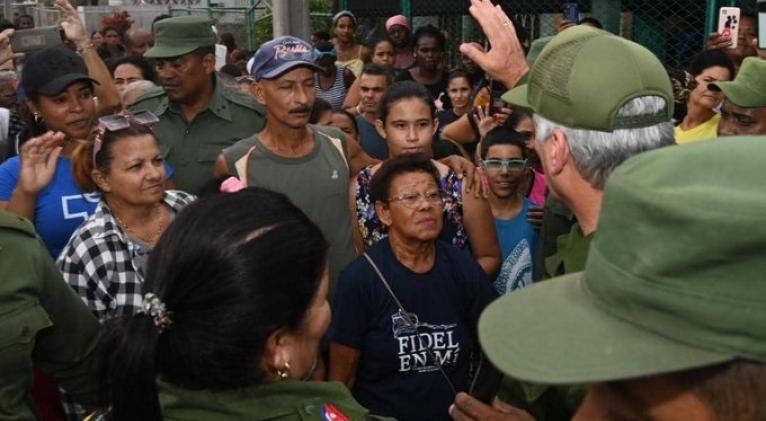Díaz-Canel Highlights the Struggle with the Aftermath of Two Hurricanes and an Earthquake
especiales

The President of the National Defense Council (NDC), Miguel Díaz-Canel Bermúdez, highlighted the intense work being carried out in Granma and Santiago de Cuba in response to the effects of the earthquake on Sunday morning near Pilón; the work being carried out in Artemisa, Havana and Mayabeque to recover from Hurricane Rafael; and the work being carried out by the people of Guantanamo to erase the traces of Hurricane Oscar, which on October 20 devastated the municipalities of San Antonio del Sur, Imías, Maisí and Baracoa.
The First Secretary of the Central Committee of the Party and President of the Republic led the review of the NDC on Monday afternoon, via videoconference, which was also led by members of the Political Bureau, Manuel Marrero Cruz, Prime Minister; Roberto Morales Ojeda, Secretary of Organization at the Central Committee, and Salvador Valdés Mesa, Vice President of the Republic.
Given the current seismic situation, special measures have been adopted in Santiago de Cuba for this entire week, including the amplification of information to the population, in which, after the psychological effect of the earthquake south of Pilón has faded, the perception of danger is decreasing, reported the first secretary of the provincial committee of the Party, Beatriz Johnson Urrutia, for whom it’s still necessary to remain alert.
She explained that on Monday evening an exercise of the management systems in the province will be carried out in the event of a high-intensity earthquake, such as those that occurred this Sunday morning, measuring six and 6.7 degrees on the Richter scale.
Johnson Urrutia recalled that the National Center for Seismological Research (CENAIS) has recorded more than 1,130 aftershocks since Sunday morning, more than fifty of them perceptible.
According to preliminary data, in Santiago de Cuba there are more than 230 houses damaged by the earthquake, in the municipalities closest to the epicenter of the event. Damages are reported in some state institutions, educational and health centers, among others.
Regarding the situation in Granma, Jorge Luis Broche Lorenzo, member of the Secretariat of the Central Committee of the Party, informed the National Defense Council, highlighting the organized response that the political and government authorities of the province have given to the earthquake.
He highlighted the work of the members of Revolutionary Armed Forces, the Ministry of the Interior, Public Health, the Electric Union and the rest of the institutions.
In Granma, he summarized, they have acted "with professionalism and speed" in the face of this "sudden and large-scale event." He underlined the work of the Party and Government cadres in the most affected communities, as well as in the 13 municipalities of the territory.
He emphasized that in light of the aftermath of the earthquake, all families must be visited, because even if they have not suffered physical or material damage, they have had a traumatic experience and it’s necessary to transmit confidence and security, as well as to maintain information and social communication through all channels.
According to preliminary data, seven injured people have been reported in the province; 2,018 houses with damage, 26 of them in total collapse, and 140 state entities with damage, such as health and education institutions. Initially, nine landslides have been reported, which have interrupted mountain roads.
He reported that the offices to process damage to houses are working, but it’s necessary to make a structural diagnosis of buildings, with specialized professionals, to certify that they are stable, that they will not collapse.
People, he explained, are asking themselves two main questions: first, if there will be another earthquake, and second, who guarantees that the house or building will not fall down. This is why these structural diagnoses, he emphasized, are necessary to restore normality and to advance in this direction in the shortest possible time.
The head of the Ministry of Construction, René Mesa Villafaña, who is in Artemisa directing the actions of workers in the sector in the recovery of this province, the most affected by Hurricane Rafael, said that 85 certified engineers will be sent to Granma and Santiago de Cuba to make diagnoses in buildings affected by earthquakes.
He also reported that specialized brigades from Granma that were working on the recovery in Guantánamo after Hurricane Oscar will return to their province to work on the mountain roads affected by landslides.
During his speech before the National Defense Council, the member of the Central Committee, Jorge Luis Broche Lorenzo, also spoke He highlighted the immediate response of workers in the electrical sector, who, despite having sent several brigades to the west in response to the damage caused by Hurricane Rafael, have faced the effects of the earthquake with their own strength.
Also accompanied by the Vice-Prime Minister Eduardo Martínez Díaz, the priorities of the authorities in the province are in Pilón, whose population strongly felt the tremors of the earthquake, and the majority of whom slept outside their homes on Sunday night, in the open air, as is appropriate in the face of this threat.
Broche Lorenzo highlighted the immediate response that was given for the cooking and distribution of food among Pilon’s locals, in which state and non-state institutions participate.
For the night of last Monday and the next few days, tents, marquees and tarps are being prepared and sent for the protected people, while medical brigades and professionals from psychology and psychiatry begin to arrive, both for adults and for the pediatric population. Students from the University of Medical Sciences and their professors will also be deployed to provide personalized attention to the inhabitants of Pilón.
RAFAEL: A BAD STORY THAT IS BEING OVERCOME
The recovery actions after Hurricane Rafael passed through Artemisa, Havana and Mayabeque, was the second point of the meeting this Monday afternoon of the National Defense Council.
Accompanied by the Vice Prime Minister Commander of the Revolution Ramiro Valdés Menéndez and the member of the Secretariat of the Central Committee Yudí Rodríguez Hernández, the member of the Political Bureau and first secretary of the provincial committee of the Party in Artemisa, Gladys Martínez Verdecia, reported that they are still caring for 245 evacuees, although solutions are being sought for their return to their daily lives.
This territory was hit hardest by the hurricane. Regarding electricity, she explained that the service is still minimal, barely covering 2% of customers, although the rehabilitation work will allow the restoration of electricity to grow progressively this week, and with it the water supply.
Fixed telephony is at 61.2%, and mobile at 34.4%, a process that is accelerating with the arrival of ETECSA brigades from six provinces. Meanwhile, the collection of solid waste is gradually advancing.
Preliminary, in Artemisa there are 15,453 homes with damages —total and partial collapses as well as total and partial loss of roofs, mostly the latter. She indicated that resources are arriving to advance in the recovery.
Attention is being paid to health facilities, especially to the rehabilitation of hospitals in the city of Artemisa and the pediatric hospital in Guanajay and the hospitals in San Antonio de los Baños and San Cristóbal.
In agriculture, Martínez Verdecia reported, 15,192 hectares of affected crops have been replanted; nearly a thousand have been recovered, including 610 hectares of bananas that were being cultivated; work is being done on the immediate recovery of eleven central pivot irrigation machines.
In Mayabeque, the school year restarted in nine of its eleven municipalities, except in Batabanó and Quivicán, the hardest hit by Rafael in this province. The 89% of the electricity company's customers have service and this Tuesday it should reach most users. The water supply covers 68% of users.
In housing, 2,213 damages are reported, mainly in Batabanó, with 1,171 cases, mainly partial loss of roofs, and in Quivicán, with 543 cases.
The damage to agriculture has led to a rethinking of the cold campaign strategy, especially in rice, beans, bananas, yucca, sweet potatoes and corn crops.
Regarding the recovery in Havana, whose authorities have the support of the member of the Secretariat of the Central Committee José Ramón Monteagudo Ruiz and the vice-prime minister Inés María Chapman Waugh, the first secretary of the provincial committee, Liván Izquierdo Alonso, reported. He indicated that the school year restarted this Monday in 1,209 schools and that 92.38% of the students attended.
The water service is at 72.2% and work is being done to recover the affected systems and pumps; nearly half a million inhabitants of Havana are still without supply.
In the early hours of Monday afternoon, electricity was restored for 96.14% of the clients. Some 16 circuits are still not energized, mainly in Boyeros and La Lisa. In the capital, 22 families, with 86 people, remained evacuated. In the housing sector, 932 people were reported affected; more than 3,000 people have been assisted in the processing offices.
FROM OSCAR, EVER FEWER
In the check-up this Monday of the National Defense Council on the situation due to the earthquake in the south-central part of the country, and the eastern region and the recovery from hurricanes Rafael and Oscar, also reported the first secretary of the provincial committee of the Party in Guantánamo, Yoel Pérez García.
He pointed out that the school year in the province began this Monday, with the majority of the educational institutions recovered in San Antonio del Sur, Imías, Maisí and Baracoa, the four municipalities severely hit by the hurricane in October.
99.6% of the electrical service is restored, as well as 93% of the water supply and 87% of the communications. The recovery of the mountain roads is progressing and a first-class professional team is evaluating the solutions that will be given to the Viaduct de La Farola.
Translated by Amilkal Labañino / CubaSí Translation Staff














Add new comment